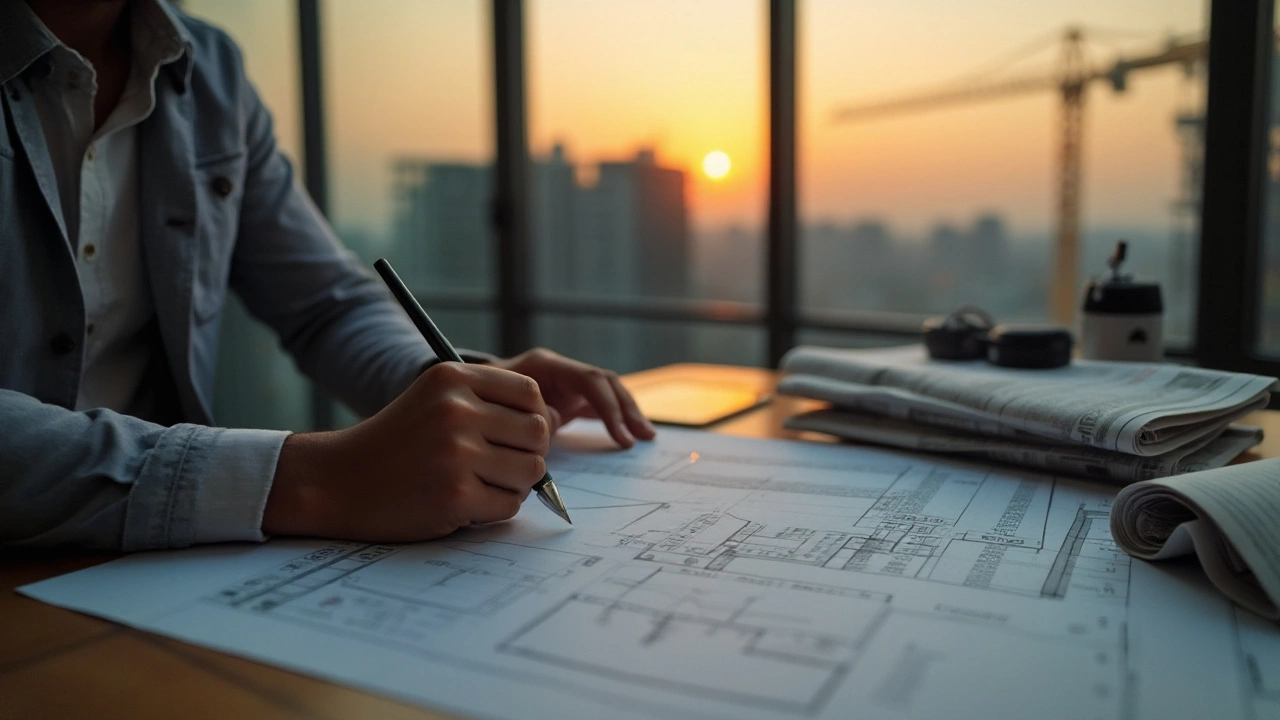Navigating the housing market in 2025 requires a bit of research and a lot of soul-searching. For many, the decision to build anew or purchase an existing home is one of life's significant milestones, teeming with pros and cons. As construction innovations spark changes and the real estate landscape continues to shift, it's vital to weigh all the options.
Whether you're drawn to a specific location, looking to customize your ideal living space, or working within a tight budget, understanding the current market dynamics can make all the difference. Let's dig into the nuances that come with either path—building or buying—and see which suits your needs and resources best.
- Current Real Estate Market Trends
- Cost Analysis: Building vs. Buying
- Factors Influencing Cost
- Potential Benefits of New Builds
- Challenges and Considerations
Current Real Estate Market Trends
The real estate market in 2025 presents a unique tapestry of possibilities and challenges, reflecting broader economic developments and shifting consumer preferences. One of the more notable trends is the increased demand for sustainable and energy-efficient homes. As environmental consciousness shapes many aspects of life, homebuyers are looking for properties that feature solar panels, smart home technologies, and eco-friendly building materials. This demand stems not only from a desire to reduce carbon footprints but also from the potential long-term savings on energy bills.
In recent years, metropolitan areas have seen a surge in property values, often outpacing the rate of income growth. This discrepancy has led many to explore options outside traditional urban centers. Suburban and even rural areas now attract those seeking more affordable living spaces without sacrificing amenities. Real estate analysts suggest that this shift is supported by remote work opportunities that have become increasingly viable and popular. According to a recent study by the National Association of Realtors, the median home price has risen approximately 5% annually since 2020, partly driven by this migration.
“The landscape of home buying and building is undergoing a transformation as people re-evaluate their living arrangements and priorities,” said Jane Doe, a leading real estate economist. “This is a time of great opportunity if one knows where to look and how to negotiate the intricate market dynamics.”
Another significant trend is the growing preference for multi-functional spaces. More buyers now prioritize home offices and flexible living areas that can adapt to changing needs. This evolution reflects a broader societal shift towards versatility in both work and lifestyle. Builders and architects have taken note, offering customizable floor plans that accommodate these preferences without inflating costs. This adaptability is crucial in maintaining competitive edge as the market confronts the complex tapestry of buyer needs.
The supply chain challenges faced during the pandemic have also left echoes in the real estate domain. Building materials like lumber and steel have historically experienced price volatility, impacting new build costs. In response, innovative materials and techniques have emerged, promising both affordability and resilience. As technology drives down construction labor costs through automation and prefabrication, it opens new pathways for those contemplating whether to build or purchase. Such insights are key for potential homeowners looking to navigate the often-turbulent waters of home acquisition.
Cost Analysis: Building vs. Buying
When considering whether to build a new home or purchase an existing one in 2025, it's crucial to dissect the costs involved. The financial landscape has seen dramatic shifts, fueled by material shortages and labor market variability. Building a home remains attractive due to modern designs and advanced energy-efficient technologies, yet buying a property offers rapid occupancy and possibly, a more stable financial outlay. Many often question which of these scenarios aligns better with their financial goals and lifestyle dreams. Let's delve into the specifics.
The cost of building your own house can be as thrilling as it is daunting. Upfront, you must consider expenses like buying land, obtaining construction permits, and the outlay for materials, which has been susceptible to fluctuations post-pandemic. In 2023, data suggested lumber prices normalized, contributing to a moderate cost decrease for frames. But labor costs skyrocketed due to skilled worker shortages. Then there's the allure of customization—being able to choose everything from the overall architectural style to the kind of kitchen countertop. These choices can significantly impact the budget, often pushing the costs beyond initial estimates.
"The decision between building or buying a home has become increasingly complex, as material costs can rise unexpectedly, whereas purchasing a completed home could mean paying into a market premium," noted by Valerie Corelli, a real estate expert from a leading market analysis firm.
Buying a property has its share of advantages too, primarily because it offers predictability in costs. You can see exactly what you're getting, there's room for negotiation, and in many cases, you'll have no unpleasant surprises around foundation settling or other unexpected construction woes. Yet, the downside might be inheriting older systems requiring maintenance or upgrades to meet your energy savings desires. As the real estate market varies greatly by region, there's an enormous disparity in pricing, with metropolitan areas often demanding a significant premium compared to smaller, suburban settings.
Factors Affecting Costs
Several factors closely tied to the economic environment play a significant role in the cost comparison between building and buying. Real estate market trends dictate the value of existing homes, which can be swayed by interest rates, housing supply and demand, and regional economic policies. Historically low interest rates in the past years have boosted buying affordability, though a slow shift towards normalization interests remains a watchful factor. Inflation pressures, significantly noticed between 2020 and 2023, have also contributed to increased costs for raw materials when building.
A detailed comparison should also consider what experts refer to as the 'hidden costs.' When building, apart from apparent expenses like design fees and utility hook-ups, are potential fees for landscaping or unexpected drainage solutions. Conversely, buying an older home may conceal issues needing expensive repair and renovation, although sellers are usually encouraged to disclose all known issues, it’s wise to budget for unpredictability. In 2025, real estate market specialists tend to advise getting a full inspection report before deciding, making it part of the purchase contract negotiation.
| Aspect | Building | Buying |
|---|---|---|
| Customization | High | Low to Medium |
| Immediate Occupancy | No | Yes |
| Price Stability | Variable | Moderate |
| Maintenance Costs | Lower Initially | Varies |
In evaluating whether to build or to buy, understanding these elements can guide in making more informed, financial decisions. Each option carries distinct opportunities and challenges depending on your reliance on the construction cost volatility or the desirability of entering the dynamic real estate market trading space. The best choice ultimately reflects personal priorities, financial capacity, and the willingness to navigate potential construction crescendos.

Factors Influencing Cost
Understanding what shapes the costs of building versus buying a home in 2025 involves a deep dive into the many elements influencing the real estate market. One of the primary factors is the location. Different regions come with varying price tags for homes and land, influenced by economy, demand, and even climate. Urban areas typically feature higher costs for both land and construction materials than rural sectors. This difference can be substantial, with prices sometimes doubling or tripling between regions.
Material costs play a vital role in the decision to build or buy. The price of construction materials such as timber, steel, and concrete has been subject to frequent fluctuations due to global supply chain disruptions and changing import-export policies. The push towards sustainability adds another layer of complexity, with eco-friendly options often being more costly but promising long-term savings and environmental benefits. Adding to this, labor costs must be considered. Skilled labor shortages in many areas mean that hiring construction professionals can become a significant expense if you're opting to build anew.
Interest rates and financial lending conditions can make a world of difference when weighing your options. As of 2025, these rates have been relatively volatile, influenced by global economic tensions and recovery from past financial downturns. Prospective homebuilders and buyers should assess how changes in interest can affect mortgage repayments or construction loans. An unforeseen hike could mean an increase in monthly payments, thus impacting long-term affordability.
Permitting and regulatory fees should not be overlooked, as these can vary widely depending on your location. Some municipalities might enforce strict building codes and environmental regulations, potentially adding weeks or months of time and significant additional cost to the overall project. On the flip side, buying an existing home might save you from some of these bureaucratic headaches but might require spending more on upgrades or renovations to suit your tastes or comply with current safety standards.
Another factor that often gets overlooked is technology. With the rise of smart homes and modern automation, new builds offer the opportunity to integrate cutting-edge technology from the ground up. This can provide not only enhanced convenience and efficiency but can increase home value. However, these advanced systems can add significantly to upfront costs, whereas existing homes may require a tech retrofit at an additional expense.
"Building a home is a journey of bringing dreams to life, yet it's wise to prepare for unpredictable curves along the way." - Unknown
Lastly, the volatile housing market itself can't be ignored. With inventory levels, buyer competition, and economic health shaping home prices, both options have their price pressures. Whether you're buying or building, connecting with an experienced real estate agent or financial advisor can offer personalized insights into current trends and help navigate these dynamics, ensuring you're making a decision in your best interest.
Potential Benefits of New Builds
When considering whether to embark on the journey of creating a new home from scratch or to purchase an already existing property, the allure of new builds often shines bright. One of the most significant appeals of new builds is the opportunity to craft a living space that's truly yours from the ground up. This customization doesn't just stop at floor plans or aesthetics; it extends to modern technology, energy efficiency, and materials that can drastically reduce living costs over time. Statistics indicate that homes built within the last few years consume up to 21% less energy than older ones, thanks to advanced insulation techniques and smart home features.
Then, there's the often underestimated benefit of a fresh start. New homes come with the peace of mind of being compliant with the latest codes and standards, reducing the risk of costly repairs that older homes might entail. The thought of bypassing issues like outdated electrical wiring or hidden mold problems can be a decisive factor for many. According to a survey, 70% of new homebuyers report being delighted with the minimal maintenance their new constructions require, allowing them to invest more time and resources in personalizing and enhancing other aspects of their new home environment.
"New homes are built to last," states Kay Lee, a veteran real estate analyst with over 20 years in the industry. "The structural integrity of recent constructions, combined with modern materials, means that homeowners are less likely to face unpredictable expenses related to wear and tear compared to older homes."
A new build also offers the luxury of choice regarding location within a community, sometimes with better proximity to infrastructure developments like new schools, parks, or transport hubs. Builders often provide flexible options that include integrated smart technology, such as thermostats that learn your habits or appliances you can control remotely. This technology integration doesn't just enhance convenience; it contributes to property value appreciation, a crucial consideration in any real estate investment.
Financially speaking, while the upfront costs of building might appear daunting, tax benefits can sweeten the deal significantly. In some regions, tax incentives geared towards sustainable builds can substantially offset initial expenses. Moreover, new builds can have lower home insurance rates due to the minimized risk factors compared to older residences. Real estate market trends show a growing preference for transparent costs associated with new constructions, diminishing the uncertainties that tend to accompany established home purchases.
In essence, the decision to construct a new home stems from a blend of emotional desires and practical considerations. The seamless integration of the latest in design, technology, and sustainability reflects a contemporary lifestyle that many buyers seek in 2025. This approach can lead to long-term savings and satisfaction, making new builds a compelling choice in the current home building landscape.

Challenges and Considerations
Choosing between home building and buying a house surfaces a plethora of considerations that every prospective homeowner should weigh carefully. The decision often comes tangled in a web of potential challenges. Building a new house might seem like a chance to sculpt your dream home from scratch, but the path is fraught with possible delays and escalating construction costs. An endless parade of permits, inspections, and changing regulations can quickly transform an exciting venture into an overwhelming ordeal. Buying, on the other hand, may offer immediacy but lacks customization, leading to potential compromise on key aspects like layout or location.
One major challenge stems from fluctuating prices in the real estate market. Materials like lumber and steel are subject to market vagaries, and post-pandemic pressures have only amplified these swings. According to the National Association of Home Builders, in mid-2023, material costs rose by over 20% compared to the previous year, affecting project budgets significantly.
"The industry is still grappling with supply chain issues that emerged during the pandemic, making building both unpredictable and costly," stated a report by the Federal Reserve.Such unpredictability can strain budgets, requiring a financial cushion that not every builder anticipates. Conversely, buying offers fixed cost advantages, yet it risks purchasing a home that may need unforeseen repairs or updates post-purchase.
The landscape can vary dramatically based on geographic location. Coastal areas may face stricter building codes due to environmental concerns, while urban settings might present hurdles with permit processes and land availability. These factors can not only extend the timeline but significantly impact the potential resale value. Unexpected legal entanglements can arise, from discovering easements on your land to demanding zoning laws that restrict what can be built. Navigating these can require expert advice, adding layers of complexity and often unseen expenses to a project budget.
Choices between aesthetics and practicality also emerge in these decisions. With new builds, there’s the luxury of selecting every detail, from energy-efficient appliances to eco-friendly materials, aligning perfectly with personal values. Yet, this customization often consumes time and resources, demanding an ongoing investment of both patience and money. A pre-existing home might not tick every box but could offer a functional stopgap while finding long-term solutions for desired changes or upgrades. This compromise could mean quicker settlement into daily life, with the opportunity to adapt spaces incrementally over time rather than facing a seemingly endless construction timeline.
In consideration of these challenges, leveraging expert advice can offer solid grounding. Employing trusted contractors, soliciting opinions from friends or colleagues who’ve taken on similar projects, and keeping an open line of communication with financial advisors can help shield against common pitfalls. It’s essential to assemble a team you trust, which means vetting potential hires scrupulously and ensuring every contract is airtight. While the complexities of home creation or purchase can seem daunting, the reward of a home tailored to your needs and desires is an aspiration worth thoroughly examining.

Written by Fletcher Abernathy
View all posts by: Fletcher Abernathy